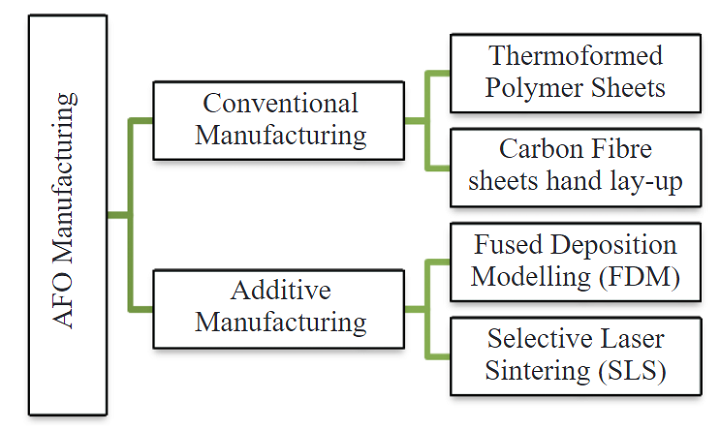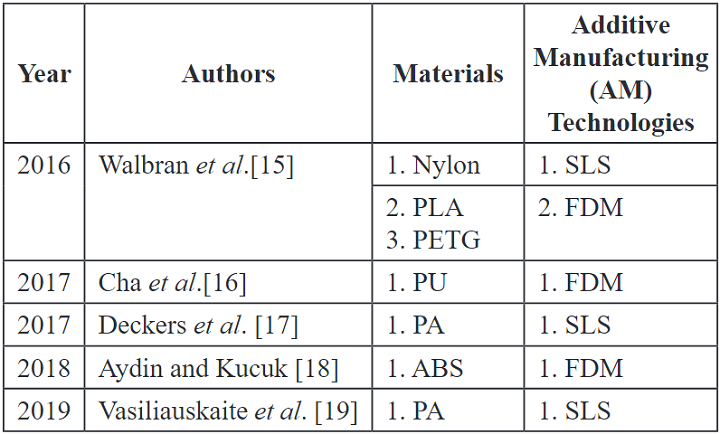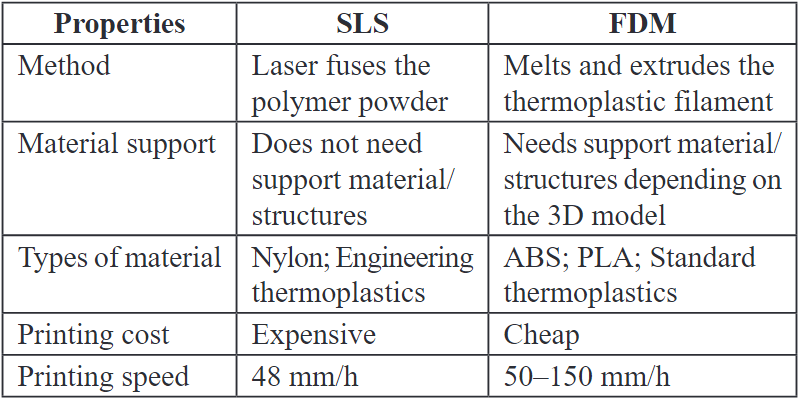An ankle-foot orthosis (AFO) is a support brace, or splint, that surrounds the region above the ankle down to the foot, and is used to treat disorders like foot drop and flat feet. Conventional methods of manufacturing used to make AFOs can take a long time, which is why 3D printing is being used more often to fabricate these.
A team of researchers from Universiti Putra Malaysia (UPM) published “A Comparative Analysis between Conventional Manufacturing and Additive Manufacturing of Ankle-Foot Orthosis” that looks at the recent research on 3D printed AFOs, and compares ones made with conventional manufacturing (CM) and additive manufacturing (AM), in addition to mechanical properties of 3D printed AFOs.
“Most of the AFO CM methods start with the creation of plaster casts to produce a positive mould which is then used as a reference to shape the AFO via either thermoforming polymer or carbon fibre sheets lay-up [1],” they wrote.
“Current researchers tried to devise a new method that eliminates the use of plaster and could directly skip to the AFO production. Thus, 3D printing was introduced in the AFO manufacturing to reduce the production stages and the time taken for the AFO production.”
AFOs made with CM typically use lightweight, inexpensive thermoformed polymer sheets, as they are “aesthetically pleasing” and can be easily shaped to a patient’s foot/ankle. Whether it’s made with 3D printing or not, a good AFO should be durable and form-fitting, lightweight, and cost-effective – qualities that both CM and AM should be able to satisfy.
Multiple types of materials, ranging from nylon and PLA to PETG and ABS, have been used to fabricate AFOs, and Fused Deposition Modeling (FDM) and Selective Laser Sintering (SLS) seem to be the most popular methods. FDM melts thermoplastic filaments, then extrudes them through a nozzle to form shapes, while SLS uses a laser beam to sinter powdered polymer materials, then binds them together to make the model.
FDM printers have at least three stages – pre-processing, production, and post-processing – and with SLS printing, the AFO needs to be moved to a cleaning station so the excess powder can be separated from the 3D printed parts.
“Although SLS and FDM are frequently used to manufacture and fabricate an AFO, both of these technologies work differently from each other,” the researchers write.
There are several differences between making an AFO with CM and making it with AM. The first begins with a manual plaster casting, which is wrapped around the patient’s ankle/foot region and removed once hardened; this is later used to make a positive model.
“Once the model is obtained, a trim line is drawn on the mould following the P&O standards. After that, a thermoformed plastic sheet is shaped by wrapping it around the positive model by using the vacuum moulding method to get a form-fitting AFO,” they explain. “After the AFO cools down, it is cut or trimmed according to the outline that has been traced on the positive mould.”
The trimmed line is grinded and smoothed, and Velcro or straps are finally added. This lengthy process requires “delicate hands-on skills.” 3D printing, however, requires a different set of skills. Forget about the plaster cast – a 3D scanner can measure the limb, and CAD/CAM software makes it easy to adjust the AFO with less waste.
“This shows that AM leans more towards a design-driven process,” the team writes.
“The process of AFO manufacturing is directly skipped into the production phase where each part of the AFO is directly manufactured from the 3D CAD file. It does not involve any lengthy process of positive mould creation and rectification, thus reducing the production time.”
The researchers also looked at the characteristics, and mechanical properties, of CM- and AM-produced AFOs. The below table shows that the Young’s Modulus and tensile strength in 3D printed AFOs are similar to that of conventionally manufactured ones – meaning that the original strength of CM-manufactured AFOs is not compromised when using AM.
“Thus, this proves that using AM could be more beneficial compared to the CM method due to the close similarities in strength and stiffness as shown in Table 4, but with a simpler manufacturing method and required skills as well as reduced production time as shown in Table 3,” they wrote.
You do need to watch for warping when 3D printing AFOs, which is why it’s imperative to pick the right materials. Polypropylene (PP) has an organized, semi-crystalline structure, so the material will cool down and solidify differently, leading to a high warping rate. But, amorphous polymers ABS and PLA have less chance of shrinkage or warping due to their “disorganized polymer chains,” and inexpensive PLA also has great tensile strength.
“Results from this review show that most current researches use Fused Deposition Modelling (FDM) or Selective Laser Sintering (SLS) for AFO manufacturing, and the materials used are mostly thermoplastics such as Nylon and Polyamide (PA),” the researchers wrote. “The results also show that the tensile strength and Young’s Modulus of a 3D-printed AFO could reach as high as 43 MPa and 3.9 GPa, respectively. It can be concluded that 3D printing provides wider opportunities in the development of AFO due to its versatility in optimizing complex geometries, time and weight savings, as well as its cost-effectiveness.”
Discuss this and other 3D printing topics at 3DPrintBoard.com or share your thoughts in the Facebook comments below.
Subscribe to Our Email Newsletter
Stay up-to-date on all the latest news from the 3D printing industry and receive information and offers from third party vendors.
You May Also Like
Gorilla Sports GE’s First 3D Printed Titanium Cast
How do you help a gorilla with a broken arm? Sounds like the start of a bad joke a zookeeper might tell, but it’s an actual dilemma recently faced by...
Nylon 3D Printed Parts Made More Functional with Coatings & Colors
Parts 3D printed from polyamide (PA, Nylon) 12 using powder bed fusion (PBF) are a mainstay in the additive manufacturing (AM) industry. While post-finishing processes have improved the porosity of...
$25M to Back Sintavia’s Largest Expansion of Metal 3D Printing Capacity Since 2019
Sintavia, the digital manufacturing company specializing in mission-critical parts for strategic sectors, announced a $25 million investment to increase its production capacity, the largest expansion to its operations since 2019....
Velo3D Initiates Public Offering in a Bid to Strengthen Financial Foundations and Drive Future Growth
Velo3D (NYSE: VLD) has been among a number of publicly traded 3D printing firms that have attempted to weather the current macroeconomic climate. After posting a challenging financial report for 2023,...





































